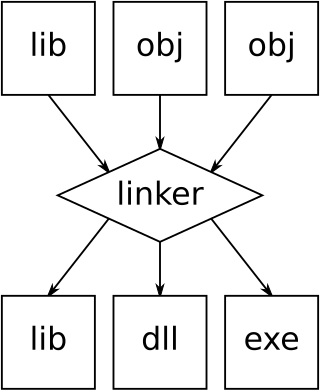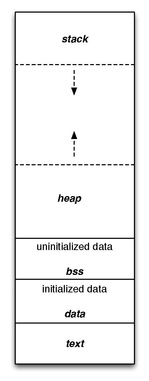C is a general-purpose computer programming language. It was created in the 1970s by Dennis Ritchie, and remains very widely used and influential. By design, C's features cleanly reflect the capabilities of the targeted CPUs. It has found lasting use in operating systems, device drivers, and protocol stacks, but its use in application software has been decreasing. C is commonly used on computer architectures that range from the largest supercomputers to the smallest microcontrollers and embedded systems.

Fortran is a general-purpose, compiled imperative programming language that is especially suited to numeric computation and scientific computing.

In computing, a linker or link editor is a computer system program that takes one or more object files and combines them into a single executable file, library file, or another "object" file.

The Netwide Assembler (NASM) is an assembler and disassembler for the Intel x86 architecture. It can be used to write 16-bit, 32-bit (IA-32) and 64-bit (x86-64) programs. It is considered one of the most popular assemblers for Linux and x86 chips.
In computer science, imperative programming is a programming paradigm of software that uses statements that change a program's state. In much the same way that the imperative mood in natural languages expresses commands, an imperative program consists of commands for the computer to perform. Imperative programming focuses on describing how a program operates step by step, rather than on high-level descriptions of its expected results.
An object file is a computer file containing object code, that is, machine code output of an assembler or compiler. The object code is usually relocatable, and not usually directly executable. There are various formats for object files, and the same machine code can be packaged in different object file formats. An object file may also work like a shared library.

OpenMP is an application programming interface (API) that supports multi-platform shared-memory multiprocessing programming in C, C++, and Fortran, on many platforms, instruction-set architectures and operating systems, including Solaris, AIX, FreeBSD, HP-UX, Linux, macOS, and Windows. It consists of a set of compiler directives, library routines, and environment variables that influence run-time behavior.
C dynamic memory allocation refers to performing manual memory management for dynamic memory allocation in the C programming language via a group of functions in the C standard library, namely malloc, realloc, calloc, aligned_alloc and free.

In computer science, a pointer is an object in many programming languages that stores a memory address. This can be that of another value located in computer memory, or in some cases, that of memory-mapped computer hardware. A pointer references a location in memory, and obtaining the value stored at that location is known as dereferencing the pointer. As an analogy, a page number in a book's index could be considered a pointer to the corresponding page; dereferencing such a pointer would be done by flipping to the page with the given page number and reading the text found on that page. The actual format and content of a pointer variable is dependent on the underlying computer architecture.
In compiler construction, name mangling is a technique used to solve various problems caused by the need to resolve unique names for programming entities in many modern programming languages.
In computer programming, a static variable is a variable that has been allocated "statically", meaning that its lifetime is the entire run of the program. This is in contrast to shorter-lived automatic variables, whose storage is stack allocated and deallocated on the call stack; and in contrast to objects, whose storage is dynamically allocated and deallocated in heap memory.
In computing, a data segment is a portion of an object file or the corresponding address space of a program that contains initialized static variables, that is, global variables and static local variables. The size of this segment is determined by the size of the values in the program's source code, and does not change at run time.
In computer programming, thread-local storage (TLS) is a memory management method that uses static or global memory local to a thread.
In computer programming, an automatic variable is a local variable which is allocated and deallocated automatically when program flow enters and leaves the variable's scope. The scope is the lexical context, particularly the function or block in which a variable is defined. Local data is typically invisible outside the function or lexical context where it is defined. Local data is also invisible and inaccessible to a called function, but is not deallocated, coming back in scope as the execution thread returns to the caller.
In Linux, the System.map file is a symbol table used by the kernel.
Interprocedural optimization (IPO) is a collection of compiler techniques used in computer programming to improve performance in programs containing many frequently used functions of small or medium length. IPO differs from other compiler optimizations by analyzing the entire program as opposed to a single function or block of code.
In the C programming language, an external variable is a variable defined outside any function block. On the other hand, a local (automatic) variable is a variable defined inside a function block.
As an alternative to automatic variables, it is possible to define variables that are external to all functions, that is, variables that can be accessed by name by any function. Because external variables are globally accessible, they can be used instead of argument lists to communicate data between functions. Furthermore, because external variables remain in existence permanently, rather than appearing and disappearing as functions are called and exited, they retain their values even after the functions that set them have returned.
In computer programming, a variable-length array (VLA), also called variable-sized or runtime-sized, is an array data structure whose length is determined at run time . In C, the VLA is said to have a variably modified type that depends on a value.
Absoft Fortran Compilers are set of Fortran compilers for Microsoft Windows, Apple Macintosh, and Linux produced by Absoft Corporation. The compilers are source code compatible across platforms.
The GOFF specification was developed for IBM's MVS operating system to supersede the IBM OS/360 Object File Format to compensate for weaknesses in the older format.





